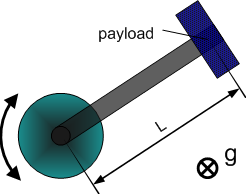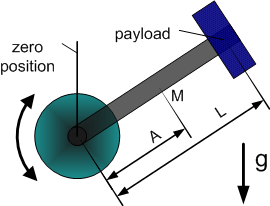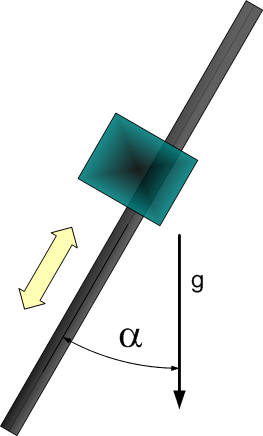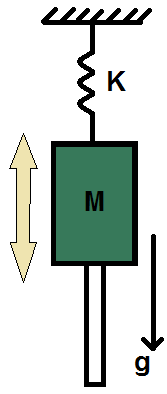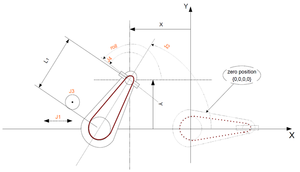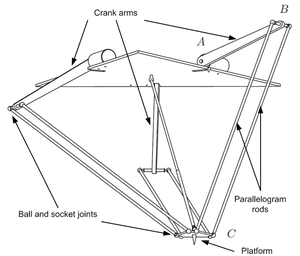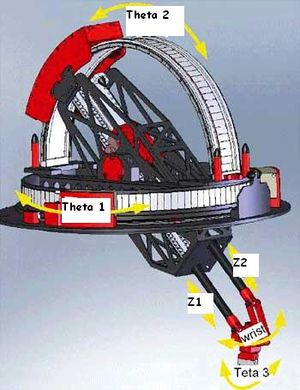Difference between revisions of "Dynamic Models"
(→Linear Axes: add image of vertical liner axis with a spring) |
(→Dynamic Model 2 - Gravity: add explanation) |
||
| Line 371: | Line 371: | ||
=== Dynamic Model 2 - Gravity === | === Dynamic Model 2 - Gravity === | ||
| + | This dynamic model is for cases where the robot moves very slowly.<br /> | ||
| + | In such cases, the accelerations and velocities of the joints of the robot have little effect on the joints torques. The joints torques are mainly affected by gravity and friction. <br /> | ||
| + | This model includes only the gravity and friction part of the PUMA robot dynamic model.<br /> | ||
{|border="1" width="80%" | {|border="1" width="80%" | ||
Revision as of 06:20, 8 October 2018
This page gives an overview over all implemented dynamic models.
General considerations
- Friction is handled on axis basis. The parameters for friction are set for each axis separately.
- Torque (Force) is always expressed in [Nm] ([N])
Contents
Rotational Axes
Dynamic Model 1 - simple rotary axis
| Number | Parameter | Comments |
|---|---|---|
| 1 | Total moment of inertia around the rotation axis of the moved part |
- Model equation
Dynamic Model 2 - horizontal crank-arm axis
| Number | Parameter | Comments |
|---|---|---|
| 1 | Total moment of inertia around the rotation axis of the moved part | |
| 2 | Square of length of crank arm (axis to payload) |
- Model equation
Dynamic Model 3 - vertical crank-arm axis
| Number | Parameter | Comments |
|---|---|---|
| 1 | Total moment of inertia around the rotation axis of the moved part | |
| 2 | Square of length of crank arm (axis to payload) | |
| 3 | Mass (without payload) * Gravity * Distance to center of mass | |
| 4 | Gravity * Distance to Payload |
- Model equation
Linear Axes
Dynamic Model 1 - horizontal axis
| Number | Parameter | Comments |
|---|---|---|
| 1 | Total mass of the moved part. |
- Model equation
Dynamic Model 2 - vertical or tilted axis
| Number | Parameter | Comments |
|---|---|---|
| 1 | Total mass of the moved part. | |
| 2 | Constant force due to gravity. | |
| 3 | Gravity coefficient used to consider payload mass. (g = 9.80665) |
- Model equation
Dynamic Model 3 - vertical axis with a spring
| Number | Parameter | Comments |
|---|---|---|
| 1 | Total mass of the moved part. [kg] | |
| 2 | The stiffness constant of the spring. [kg/s^2] | |
| 3 | The stiffness constant times the relaxation position of the spring. [kg*m/s^2] |
- Model equation
Traverse Arm Robots
Dynamic Model 1
| Number | Parameter | Comments |
|---|---|---|
| 1 | ||
| 2 | ||
| 3 | ||
| 4 | ||
| 5 | ||
| 6 | ||
| 7 |
Scara Robots
Dynamic Model 1
| Number | Parameter | Comments |
|---|---|---|
| 1 | ||
| 2 | ||
| 3 | ||
| 4 | ||
| 5 | ||
| 6 | ||
| 7 | ||
| 8 |
Delta Robots
Dynamic Model 1
| Number | Parameter | Comments |
|---|---|---|
| 1 | kg*m2 | |
| 2 | kg*m2/sec2 | |
| 3 | kg | |
| 4 | kg*m2 | |
| 5 | kg | |
| 6 | kg | |
| 7 | kg*m2 | |
| 8 | kg*m2 | |
| 9 | m | |
| 10 | m | |
| 11 | ||
| 12 | ||
| 13 | ||
| 14 |
Puma Robots
Dynamic Model 1
Description:
- - Gravity constant
- - Mass of the ith link
- - length of the common normal between the ith and ith+1 joints
- - offset along z axis between the ith and ith+1 joints
- - The distance from the ith joint to the center of mass of the ith link
| Number | Parameter | Comments |
|---|---|---|
| 1 | |
kg*m^2 |
| 2 | kg*m^2 | |
| 3 | kg*m^2 | |
| 4 | kg*m^2 | |
| 5 | kg*m^2 | |
| 6 | kg*m^2 | |
| 7 | kg*m^2 | |
| 8 | kg*m^2 | |
| 9 | kg*m^2 | |
| 10 | kg*m^2 | |
| 11 | kg*m^2 | |
| 12 | kg*m^2 | |
| 13 | kg*m^2 | |
| 14 | kg*m^2 | |
| 15 | kg*m^2 | |
| 16 | kg*m^2 | |
| 17 | kg*m^2 | |
| 18 | kg*m^2 | |
| 19 | kg*m^2 | |
| 20 | kg*m^2 | |
| 21 | kg*m^2 | |
| 22 | kg*m^2 | |
| 23 | kg*m^2 |
Dynamic Model 2 - Gravity
This dynamic model is for cases where the robot moves very slowly.
In such cases, the accelerations and velocities of the joints of the robot have little effect on the joints torques. The joints torques are mainly affected by gravity and friction.
This model includes only the gravity and friction part of the PUMA robot dynamic model.
| Number | Parameter | Comments |
|---|---|---|
| 1 | kg*m^2/s^2 | |
| 2 | kg*m^2/s^2 | |
| 3 | kg*m^2/s^2 | |
| 4 | kg*m^2/s^2 |
Galileo Spherical Robots (GSR)
Dynamic Model 1
| Number | Parameter | Comments |
|---|---|---|
| 1 | mP | Payload mass [kg] |
| 2 | mB | Balance mass [kg] |
| 3 | TP | Payload mass center distance from the flange [mm] |
| 4 | TB | Balance mass center distance from the (0,0) [mm] |
| 5 | IR | Inertia of the payload around roll [kg*m2 |


